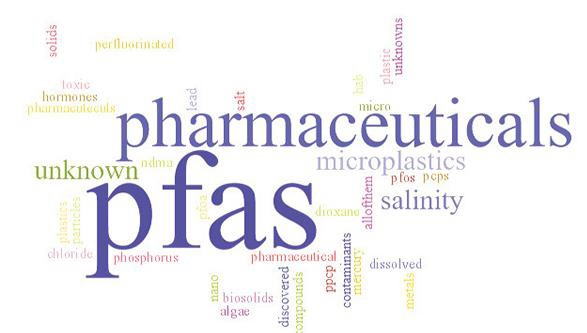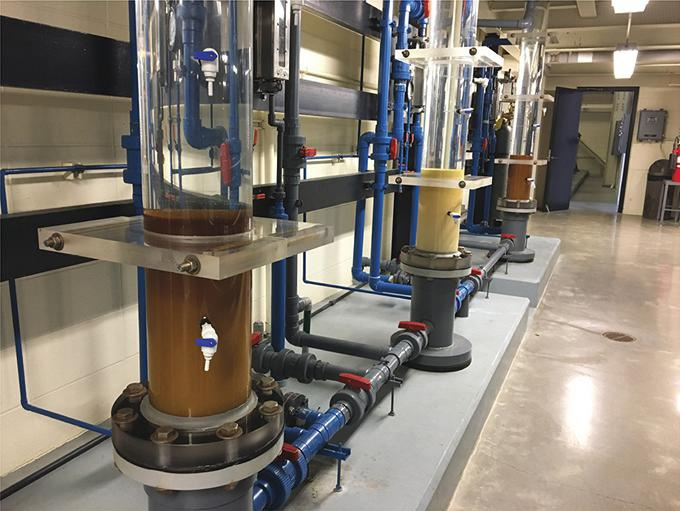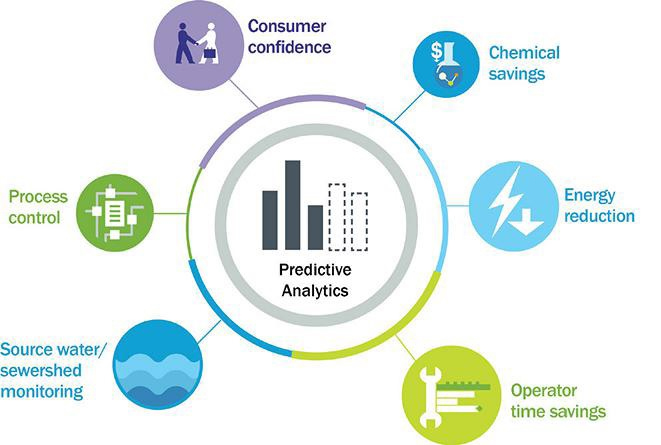From Emerging To Emerged: What These 'Here Now' Contaminants Mean For The Water Sector
By Allegra da Silva, Patricia Whitby, Wendy Broley, Cindy Paulson, Kati Bell, Si Givens, Lynn Williams Stephens, And Erin Mackey
As PFAS and a host of other pollutants threaten water systems and erode public confidence, the water industry fights back with a comprehensive action plan.
Emerging pollutants such as perfluorinated compounds, pharmaceuticals, personal care products, nanomaterials, and microplastics are showing up in our wastewater, drinking water, food products, and even polar bear tissues. These compounds originate from a variety of sources that are part of daily human life, such as household products, solvents, food packaging materials, clothing treatments, and firefighting foams (Figure 1). While these emerging contaminants are typically present in drinking water at concentrations on the order of parts-per-billion or parts-per-trillion, improvements in monitoring and analytical chemistry methods that provide quantification of these pollutants at extremely low levels have brought attention to their prevalence:
- Highly fluorinated compounds
- Antimicrobials
- Flame retardants
- Bisphenols and phthalates
- Solvents
- Metals
- Pharmaceuticals and personal care products
- Nanomaterials and microfibers
The water industry is facing challenges with respect to emerging contaminants, including issues of public confidence, monitoring, treatment, and affordability, as some state regulators move to issue new water quality requirements. Other challenges include the lack of health effect risk and exposure data for many of these constituents, along with the challenges communicating de minimis risk for certain constituents with a concerned public.
How Do These Contaminants Get In Our Water?
One essential way that emerging contaminants enter our drinking water supplies is de facto potable water reuse, otherwise known as unacknowledged or unplanned potable reuse. De facto potable reuse occurs when treated wastewater effluent is discharged upstream of a community’s raw water intake. De facto potable reuse is widespread — a seminal recent study calculated that 50 percent of the nation’s drinking water treatment plants serving greater than 10,000 people are impacted by upstream wastewater discharges, which impacts 82 percent of the nation’s population (Rice and Westerhoff, 2015). However, the same study calculated that the magnitude of de facto potable reuse is low, under-average streamflow conditions — generally less than 1 percent of the flows in the impacted water treatment plants is treated municipal wastewater. Naturally, under low streamflow conditions the relative contribution of treated municipal wastewater increases, meaning that the impact of de facto potable reuse increases in drought conditions. With increasing pressures on water availability from climate change and population growth, more water will be drawn out of river systems, and concentrations of emerging contaminants could increase in certain river systems over time.

Figure 1. Many emerging contaminants come from common household products
The use of some treatment chemicals at our treatment plants may be introducing residual contaminants that could be identified at very low concentrations. For example, coagulant aids and dewatering polymers can introduce nitrosamine compounds, including N-nitrosodimethylamine (NDMA), a probable human carcinogen, into drinking water supplies. Nitrogenous disinfection byproducts (DBPs) may be more toxic than currently regulated DBPs, including trihalomethanes and haloacetic acids (Muellner et al., 2007 and Bull et al., 2011).

Figure 2. Word cloud from NACWA conference highlighting contaminants of greatest concern for participants
Increased Public Awareness
For the entire water industry, the lead contamination crisis in Flint, MI, sent shockwaves through the public’s trust in the safety of public water supplies. A 2017 national poll revealed an uptick in public anxiety about water contaminants, with 29 percent of respondents indicating concern about the safety of drinking tap water, compared to responses in the 8 to 13 percent range in 2011, 2013, and 2015 surveys (Water Quality Association, 2017). In the same 2017 survey, 43 percent of respondents indicated they learned about health contaminants from the media. With that backdrop, popular media articles on perfluorinated compounds in drinking water (NPR, 2018) and heavy metals such as lead and arsenic in juice boxes (Consumer Reports, 2019) raise alarm with the public. Utilities are challenged in communicating risks of these contaminants to the public when fears are heightened, yet the science of risk and exposure levels is still developing. Water utilities and public agencies need to be proactive in preparing to communicate about potential water topics before they emerge. The time to act is now.
The dominant human exposure to pharmaceuticals and personal care products is through medications and daily personal care routines, yet the public, like industry representatives, has pharmaceuticals in drinking water on their mind (DrinkTap, 2019). Industry guidance on how to communicate the relative risk of exposure to these compounds from drinking water provides ways of helping the public conceptualize de minimis (trivial) relative risk (DrinkTap, 2019, AWWA, 2019, and Reekie and Fulmer, 2015).
Cost Of Compliance With Increasingly Stringent Regulations Is Staggering
Even though the interest and capability to monitor and treat emerging contaminants are growing, implementation of solutions comes at a high cost. For example, Long Island water providers have estimated it will cost $840 million, resulting in a doubling of customers’ water bills, to add costly ultraviolet advanced oxidation process (UV-AOP) treatment systems to 185 drinking water wells contaminated by 1,4-dioxane, a likely human carcinogen (Schwartz, 2019 and EPA, 2017). Extrapolated to millions of people across the country and multiple contaminants, the costs are astronomical at a time when our country is already struggling with a massive funding gap on the order of billions of dollars to address our aging infrastructure (ASCE Report Card for America’s Infrastructure, 2017). On top of that, AWWA’s Buried No Longer report (AWWA, 2017) estimates the cost of improving aging infrastructure is on the order of $1 trillion just to maintain and expand service to meet demands over the next 25 years.
Solution: Continue To Innovate Better Treatment Options
As regulatory actions and public concerns about emerging contaminants grow, the need for better, more cost-effective treatment options is driving innovation. An example of the need for innovative technologies involves the removal of 1,4-dioxane from groundwater. The move to regulate 1,4-dioxane in New York and elsewhere, combined with areas of significant occurrence, is pushing UV-AOP manufacturers and manufacturers of potential alternative technologies to put significant efforts into innovation.
The contaminant dominantly on the minds of industry participants in the informal National Association of Clean Water Agencies (NACWA) conference poll is PFAS, which has been detected in groundwater in locations across the country. PFAS compounds are present in a wide range of consumer products and have been linked to adverse health outcomes in humans (EPA, n.d.). While adsorption using specialized media such as granular activated carbon has been widely used to remove a variety of contaminants, engineers are finding ways to optimize those existing systems to target the removal of PFAS. For instance, novel adsorbents are being developed with higher selectivity and specificity for PFAS. An example is the development of ionexchange resins tailored to remove short-chained and long-chained PFAS compounds. Brown and Caldwell is working with municipal utilities and industrial clients to pilot these technologies. Even though PFAS is not currently federally regulated, individual states are developing their own policies and guidelines, and earlier this year the U.S. EPA released a PFAS Action Plan (EPA, 2019a), thus increasing demand for the development of more efficient and cost-effective removal technologies.

Figure 3. Ion-exchange pilot for PFAS removal from groundwater contaminated by industrial pollution
Solution: Monitoring For Contaminants And Treatment Process Performance
Innovations in monitoring have been driven by the scrutiny of water quality deemed necessary in planned potable reuse. Monitoring and treatment of emerging contaminants are paramount to protecting public health, as well as public confidence, particularly for planned potable reuse. Early detection of variations in treatment process operations is essential to providing these protections. Online, real-time, and offline monitoring are key to assessing process performance and to identify changes from normal operating conditions. When process performance is potentially compromised (e.g., membrane breaching) with elevated pathogen or chemical constituent concentrations, alarms can be triggered and corrective actions can be identified.
And, while there are many advanced sensors that are in the development stage, these could take months or years of operational validation. Thus, until fully validated sensor suites are commercially available, investigation into alternative means of leveraging currently accessible tools is important. New and innovative approaches to leveraging data from existing monitoring tools have the potential to change the current approach to process design and operations.
This scenario calls for the application of data analytics as a supplemental tool, enabling the use of both historical and current data sets to forecast future probabilities of the occurrence of an event that impairs specific processes. This new approach uses the extensive body of data collected through existing monitoring programs, allowing early implementation of process changes, or preemptive actions such as preventative equipment maintenance, to preclude issues from occurring.
This concept of predictive analytics has already been applied to water industry projects. For example, in Atlanta, predictive analytics is being used to compare current real-time water levels in manholes to the historical levels and identify potential blockages upstream or downstream of the utility manhole. For Thames Water in the UK, predictive analytics has successfully increased the efficiency of operations and reduced operating costs by comparing various water quality parameters to other operating data sets. The benefits of using predictive analytics and advanced monitoring approaches in the water industry are illustrated in Figure 4.

Figure 4. Using predictive analytics and advanced monitoring approaches can have many benefits
Another innovative monitoring approach is the potential use of bioassays to assess health risks from a given water sample due to mixtures of unknown chemicals, rather than focusing on searching for individual contaminants one by one. The key challenges include selection of meaningful bioassay systems, standardization of protocols, and interpretation of bioassay results. As a result, the use of bioassays in regulatory or permitting requirements is not on the near-term horizon. However, recognizing the powerful potential of bioassays to detect unknown and unanticipated contaminants, California has begun a process of attempting to select and standardize bioassays to begin to understand the opportunities and limitations that a range of bioassay approaches offers for water quality monitoring in the context of potable reuse. While challenges remain for the deployment of bioassays at scales relevant for municipal treatment and potable reuse, the wheels of innovation have been set in motion.
Solution: Engaging The Public
How can the water industry address public concerns and negative media attention to effectively shift public perceptions and regain trust? The WateReuse Foundation has funded several studies that show that having a strong communication plan built on a solid foundation of water quality data can help increase awareness and foster acceptance of direct potable reuse (WateReuse Foundation, 2015). The same type of proactive communications efforts have been proposed to facilitate dialogues about the relative risks of emerging contaminants (Reekie and Fulmer, 2015; Deeb, Sedlak, Hawley, 2014; and AWWA, n.d.). An excellent resource for developing a public communications plan around emerging contaminants is a Water Research Foundation project report titled Develop Effective Communications About Emerging Contaminant Risks (Reekie and Fulmer, 2015) and AWWA’s Public Communications Toolkit (AWWA, n.d.).
Traditional communication mechanisms between water utilities and their customers operated primarily in one direction: providing information pamphlets and distributing water use reports and bills. Today, information technology applications and interactive communication mechanisms allow customers to be more connected to their water than ever before, through activities such as tracking their water consumption in real time and participating in discussions through social media. A celebrated example of the latter is the social media presence of the Northeast Ohio Regional Sewer District (NEORSD). NEORSD’s quirky social media messaging not only helps catch customers’ attention in the noisy online sphere, but also helps bring attention to important initiatives. By plugging into buzzy topics such as the Super Bowl or Valentine’s Day — or just using online buzzwords and humor — NEORSD enhances the public's understanding of rate increases, the company’s regional stormwater management program, and campaigns such as Project Clean Lake. In addition, utilities are banding together with social scientists to develop tailored messaging campaigns that help customers understand the treatment processes that go behind securing the quality of public supplies. Enhanced two-way communication pathways may seem like a simple solution, but they represent an important innovation in the water industry with significant untapped potential. In the long run, these efforts can lead not only to increased trust in the water industry, but also to the establishment of communication channels for spotting and addressing issues before public fears become widespread.
Solution: Addressing Affordability
When additional treatment is needed to effectively address the risk associated with certain emerging contaminants such as PFAS and 1,4-dioxane, how do utilities achieve this amidst today’s financial constraints and affordability issues? The cost of providing advanced treatment does not cancel out the need to maintain and upgrade infrastructure, comply with existing regulations, and service existing debt — all of which fall on the ratepayer and affect affordability, a competing value that utilities must strive to address. It behooves utilities to be proactive in the discussion around the cost and benefit of developing new regulations around emerging contaminants to ensure the treatment cost estimates are realistic. Is the real cost proportional to the benefit?
Another part of the discussion is broadening water supply planning and projects to rethink how our water systems are designed and built. For example, with increasing stress on both the quality and quantity of our limited resources, water reuse is on the rise. However, the absence of available and appropriate funding resources has been a financial barrier to the adoption of technological solutions in our water infrastructure systems, especially for smaller municipal systems laden with affordability issues and limited revenue streams. Overcoming this barrier requires innovative financing and governance mechanisms beyond what has traditionally been done in the water sector.
Recent reviews recommend looking at the energy sector for examples outside the box, such as integrating distributed systems (think onsite water reuse facilities and green infrastructure) and aggregating several projects to leverage a diverse pool of funding sources (Quesnel, Ajami, and Wyss, 2017). An example of this approach is San Francisco’s Non-Potable Water Program. In 2012, the city and county of San Francisco adopted the Onsite Water Reuse for Commercial, Multi-family, and Mixed-Use Development Ordinance, which allows the collection, treatment, and use of alternate water sources for non-potable applications (SFPUC, 2018). The program provides guidelines, grants, and technical support, and allows stakeholders to work together to develop shared water systems between multiple buildings at the district-scale. By establishing both a regulatory driver and economic incentives, this program streamlines the adoption of advanced technologies that make water reuse systems safe and reliable. The approach not only prompts water users to leverage public and private funding in the development of water reuse systems, but also helps San Francisco conserve and diversify its precious water supplies (Quesnel, Ajami, and Wyss, 2017). Keeping the big picture in mind, rather than narrowly focusing on the cost of a given treatment approach, can help justify investments and gain public buy-in.
Innovate, Collaborate ... Thrive
With the increased awareness and public scrutiny of emerging contaminants in our water supplies, our industry is faced with overcoming these challenges in new and creative ways to ensure our drinking water protects public health while maintaining affordability and reliability. Taking an innovative approach to monitoring, treatment, communication, and financing can create breakthroughs for communities grappling with how to effectively manage the mounting demands for action.
The good news is that there are great examples of where we’re getting it right. Now, more than ever, utilities are acknowledging the interconnectedness of our water systems — stormwater, wastewater, reuse, potable water — and working to intentionally close the loop. Applications such as planned potable reuse are helping utilities to actually enhance drinking water quality while improving supply reliability and gaining focus at the highest levels. Recently, the EPA announced the development of a Water Reuse Action Plan that will leverage the expertise of both industry and government to ensure the effective use of the nation’s water resources (EPA, 2019b). The plan will bring together experts across the water sector to identify a path forward to foster water reuse as a component of integrated water resource management. The EPA will facilitate discussions among federal, state, and water sector stakeholders and form new partnerships to not only develop but ultimately deploy the plan. This vehicle of facilitation and collaboration in the water industry is key, as utilities continue to leverage partnerships and work in harmony to share resources and implement innovative solutions.
Addressing emerging contaminants often requires the participation of municipal agencies and industry to identify, evaluate, finance, and implement the appropriate solutions. And in some cases, the solution is to not put it into the system in the first place. For example, back in 2015, there was a significant issue regarding the proliferation of microbeads in beauty supplies and other household products. Microplastics are very small, but they can cause big problems for the environment, eventually making their way into the food chain as well as drinking water supplies. Subsequently, the water industry launched a successful campaign to ban microbeads, first in California, and then nationwide. By 2017, it was illegal to sell personal care products containing microbeads. Eliminating microbeads is a great example of what happens when our industry works together to impact policy and regulatory change. Let's continue to innovate in the realms of policy, treatment, monitoring, and public outreach to help address the challenge of emerging contaminants in our water supplies today.
About The Authors
All authors represent Brown and Caldwell, the largest engineering consulting firm solely focused on the U.S. environmental sector, with headquarters in Walnut Creek, CA. Email: AdaSilva@BrwnCald.com
References
ASCE (2017). Infrastructure Report Card. Retrieved fromhttps://www.infrastructurereportcard.org/wp-content/uploads/2017/01/Drinking-Water-Final.pdf
AWWA (2017). Buried No Longer: Confronting America’s Water Infrastructure Challenge. Retrieved from http://www.urbanwaterslearningnetwork.org/wp-content/uploads/2017/08/AmericanWaterWorksBuriedNoLonger2017.pdf
AWWA (no date) Public Communications Toolkit. Retrieved from https://www.awwa.org/Resources-Tools/Public-Affairs/Public-Communications-Toolkit
Brady, J. (2018). Decades-Old Chemicals, New Angst Over Drinking Water. NPR. Retrieved from https://www.npr.org/2018/10/02/651180024/decades-old-chemicals-new-angst-over-drinking-water
Bull, R.J., Reckhow, D.A., Li, X., Humpage, A.R., Joll, C. and Hrudey, S.E., 2011. Potential carcinogenic hazards of non-regulated disinfection by-products: haloquinones, halo-cyclopentene and cyclohexene derivatives, N-halamines, halonitriles, and heterocyclic amines. Toxicology, 286(1-3), pp.1-19.
Deeb, R. , Sedlak, D., and Hawley, E. (2014). National Dialogue on Contaminants of Emerging Concern and Public Health. Water Research Foundation. Web Report #4463.
DrinkTap (2019) Pharmaceuticals and Personal Care Products. Retrieved from https://drinktap.org/Water-Info/Whats-in-My-Water/Pharmaceuticals-and-Personal-Care-Products
Environmental Protection Agency (EPA) Basic Information on PFAS. Retrieved from https://www.epa.gov/pfas/basic-information-pfas
EPA (2017) Technical Fact Sheet – 1,4-Dioxane. Retrieved from https://www.epa.gov/sites/production/files/2014-03/documents/ffrro_factsheet_contaminant_14-dioxane_january2014_final.pdf
EPA (2019a). EPA’s Per- and Polyfluoroalkyl Substances (PFAS) Action Plan. United States Environmental Protection Agency. Retrieved from https://www.epa.gov/pfas/epas-pfas-action-plan
Environmental Protection Agency (EPA) (2019b). EPA Announces Development of Water Reuse Action Plan. United States Environmental Protection Agency. Retrieved from https://www.epa.gov/newsreleases/epa-announces-development-water-reuse-action-plan
Hirsch, J. (2019). Arsenic and Lead Are in Your Fruit Juice: What You Need to Know. Consumer Reports. Retrieved from: https://www.consumerreports.org/food-safety/arsenic-and-lead-are-in-your-fruit-juice-what-you-need-to-know/
Humphreys, L. (2006). Marketing Nonpotable Recycled Water- A Guidebook for Successful Public Outreach and Customer Marketing. WateReuse Foundation. Retrieved from https://www.waterboards.ca.gov/water_issues/programs/grants_loans/water_recycling/research/03_005_01.pdf
Kohut, K. and Andrews, S. (2003). Polyelectrolyte Age and N-Nitrosodimethylamine Formation in Drinking Water Treatment. Water Quality Research Journal of Canada (38) 4, 719 – 735.
Muellner, M.G., Wagner, E.D., McCalla, K., Richardson, S.D., Woo, Y.T. and Plewa, M.J., 2007. Haloacetonitriles vs. regulated haloacetic acids: are nitrogen-containing DBPs more toxic?. Environmental Science & Technology, 41(2), pp.645-651.
Najm, I. and Trussell, R. (2001). NDMA Formation in Water and Wastewater. Journal AWWA (93) 2, 92 – 99.
Quesnel, K., Ajami, N., and Wyss, N. (2017). Accelerating the Integration of Distributed Water Solutions: A Conceptual Financing Model from the Electricity Sector. Environmental Management (60) 5, 867 – 881.
Reekie, L. and Fulmer, A. (2015). Develop Effective Communications About Emerging Contaminant Risks. American Water Works Association Opflow (41) 8, 22 – 24.
Rice, J. and Westerhoff, P. (2015) Spatial and Temporal Variation in De Facto Wastewater Reuse in Drinking Water Systems across the U.S.A., Environmental Science & Technology, 49, 982-989.
SFPUC (2018). Non-potable Water Program Guidebook- A Guide for Implementing Onsite Non-potable Water Systems in San Francisco. San Francisco Public Utilities Commission. Retrieved from https://sfwater.org/Modules/ShowDocument.aspx?documentID=11629
Schwartz, D. (2019). “Water providers put cost for 1,4-dioxane treatment systems at $840M”. Newsday.com. Retrieved from https://www.newsday.com/long-island/1-4-dioxane-cleanup-costs-1.27268149
WateReuse Foundation (2015). Model Communication Plans for Increasing Awareness and Fostering Acceptance of Direct Potable Reuse. Retrieved from https://watereuse.org/watereuse-research/13-02-model-communication-plans-for-increasing-awareness-and-fostering-acceptance-of-direct-potable-reuse/
Water Quality Association (2017). Summary and Highlights- National Study of Consumers’ Opinions and Perceptions Regarding Water Quality, 2017 Edition. Retrieved from https://www.wqa.org/Portals/0/Publications/ConsumerStudy2017_Public.pdf
